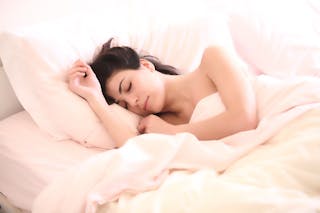Creating An Asexual Character For TV Showed Me We Have A Way To Go
Are you tired of seeing the same old clichéd romantic storylines on TV? It's time for some refreshing representation! Check out this eye-opening article on Dating Tales to explore the world of diverse character portrayal, including asexual characters in TV shows. It's time to break free from the status quo and embrace the true spectrum of human experiences.
When it comes to representation in the media, there's still a long way to go. As a member of the asexual community, I've often felt overlooked and misunderstood when it comes to portrayal in popular TV shows and movies. However, recently I came across a character on a popular TV show that was asexual, and it made me realize just how much progress still needs to be made.
Unleash your desires in the comfort of your own space and explore the world of BDSM at home with the guidance of this blog.
The Asexual Community
If you're interested in exploring Asian chat rooms, be sure to check out this website and see what it has to offer.
Before we delve into the representation of asexual characters in the media, let's first understand what it means to be asexual. Asexuality is a sexual orientation where a person experiences little to no sexual attraction to others. This doesn't mean that asexual individuals don't experience romantic or emotional attraction, but rather that they don't feel the same level of sexual desire that is commonly portrayed in the media.
Discover the steamy romance of Bournemouth in this local love affair article
For a long time, asexuality has been largely ignored and misunderstood by society. Many people still struggle to comprehend the concept of not feeling sexual attraction, and this lack of understanding is reflected in the media.
Asexual Representation in TV Shows
While there have been some strides in recent years to include asexual characters in TV shows, the representation is still lacking. Often, asexuality is portrayed as a punchline or as a character who just hasn't found the right person yet. This does a disservice to the asexual community and perpetuates harmful stereotypes.
One recent example of asexual representation in the media is Todd Chavez from the show "BoJack Horseman." Todd's asexuality is a central part of his character, and the show does a decent job of exploring his experiences. However, even in this case, there are still moments where Todd's asexuality is used for comedic effect, rather than being treated with the respect it deserves.
The Impact of Misrepresentation
As a member of the asexual community, seeing these misrepresentations in the media can be disheartening. It sends the message that asexuality is something to be laughed at or dismissed, rather than being a valid and legitimate orientation. This can lead to feelings of isolation and invalidation for asexual individuals, further perpetuating the idea that they are abnormal or broken.
Furthermore, these misrepresentations can also impact how asexual individuals are perceived in real life. If the only exposure people have to asexuality is through inaccurate portrayals in the media, it can lead to misconceptions and ignorance about what it means to be asexual. This can make it even more challenging for asexual individuals to navigate relationships and dating, as they may face judgment and disbelief from others.
The Need for Authentic Representation
What the asexual community truly needs is authentic representation in the media. Asexual characters should be portrayed as multi-dimensional individuals with hopes, dreams, and struggles just like anyone else. Their asexuality should not be the butt of a joke or a plot device, but rather a respected and integral part of who they are.
By including authentic asexual representation in TV shows and movies, we can help to educate the public about asexuality and break down harmful stereotypes. This can create a more accepting and inclusive society where asexual individuals feel seen and understood.
Moving Forward
While there is still a long way to go in terms of asexual representation in the media, I am hopeful that we are moving in the right direction. More and more people are speaking out about the need for accurate and respectful portrayal of asexuality, and I believe that this will lead to positive change in the future.
As we continue to push for authentic representation, it's important for allies to support the asexual community and amplify their voices. By working together, we can create a media landscape that accurately reflects the diversity of human experience, including asexuality.
In conclusion, the representation of asexual characters in TV shows and movies has come a long way, but there is still much work to be done. By advocating for authentic and respectful portrayal of asexuality, we can create a more inclusive and understanding society for all.
- https://online-dating.fu-direct.net/posts/inside-the-speed-dating-revolution-and-the-communities/
- https://dating-guide.getweps.com/posts/orgy-orgy-sex-stories/
- https://chatting.campsupernow.com/posts/dating-men-called-daniel-heres-why-i-dated-8-men-with-the-same-name/
- https://flirting.themountaintopplay.com/posts/9-ways-to-make-your-boyfriend-better-at-oral-sex/
- https://hookup-website.ua-sex.com/posts/dating-resolutions-how-to-shake-up-your-dating-game/
- https://dating-guide.campsupernow.com/posts/vanilla-sex-what-is-vanilla-sex/
- https://sex-chat.getweps.com/posts/free-sex-education-videos-from-porn-director-erika-lust/
- https://dating-for-free.fu-direct.net/posts/the-14-best-clit-suction-stimulators-for-oral-sex-fans-for-2024/
- https://meet-women.themountaintopplay.com/posts/what-does-it-mean-to-be-fraysexual/
- https://hookupsites.getweps.com/posts/beach-sex-16-beach-sex-stories/
- https://hookupsites.thehottieandthenottie.com/posts/ditching-the-dating-apps-can-we-still-find-love-irl/
- https://hookupsites.thehottieandthenottie.com/posts/dating-trends-for-2024-from-apps-to-the-death-of-having-a-type/
- https://hookupguide.campsupernow.com/posts/sex-sex-positions-and-tips/
- https://online-personals.campsupernow.com/posts/three-minute-game-could-revolutionise-your-sex-life/
